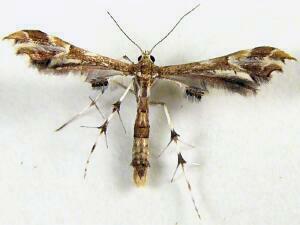| Problems in Identification: Similar Species
Indistinguishable In Photographs |
All of the major moth families contain species
pairs or groups in which it is extremely difficult, even impossible,
to distinguish individual species from photographs. In such cases it
is necessary to depend on measurements, geographic location,
examination of internal genitalia, or DNA "bar-coding." A few specific
cases are illustrated further below. Shown here is one representative
from each of three genera that are particularly vexing to
photographers and collectors. All of these are in the family
Geometridae.
|
 Eupithecia -- © John Davis
Eupithecia -- © John Davis
|
 Hydriomena -- © John Davis
Hydriomena -- © John Davis |
 Macaria -- © Robert Patterson Macaria -- © Robert Patterson
| |
| 2301 -- Dichomeris Species Group -- Dichomeris
serrativittella grp. |
|
|
| 3188-90 -- Epiblema Sp. Grp. -- E.
discretivana-obfuscana-desertana |
 © Tom Murray
© Tom Murray
|
 © Hugh McGuinness
© Hugh McGuinness |
 © Robert Patterson © Robert Patterson |
 © Robert Patterson © Robert Patterson
| |
| The Plume Moths -- Pterophoridae |
The three moths shown below are listed on the plate
for Pterophoridae as Sphenarches ontario, Geina
periscelidactyla and Geina sheppardi. But in each case there
is a notation pointing out two other species which might also be
considered. Most of the Plume Moths can't be identified with certainty
based on photographs. There are simply too many species that share
coloration and pattern. Genitalia are the keys to solid IDs.
|
 © Dave Pelletier
© Dave Pelletier
|
 © Robert Patterson © Robert Patterson |
 © Nolie Schneider
© Nolie Schneider
| |
| A Black-lettered Dart -- Xestia dolosa and Xestia
c-nigrum |
These two species are very difficult to identify in
the absence of accurate measurments. Hugh McGuinness has culled from
among many of his photographs examples that come closest to matching the
descriptions given by Don Lafontaine in MONA fascicle 27.3 (1998).
|
 [m.] - Xestia c-nigrum - 14-18 mm
[m.] - Xestia c-nigrum - 14-18 mm
|
 [f.] - Xestia c-nigrum - 14-18 mm
[f.] - Xestia c-nigrum - 14-18 mm
|
 [m.] - Xestia dolosa - 18-24 mm [m.] - Xestia dolosa - 18-24 mm
|
 [f.] - Xestia dolosa - 18-24 mm [f.] - Xestia dolosa - 18-24 mm
| |
| 6740-44 -- Crocus Geometer Species Group -- Xanthotype
sp. |
|
|
 Eupithecia -- © John Davis
Eupithecia -- © John Davis  Hydriomena -- © John Davis
Hydriomena -- © John Davis  Macaria -- © Robert Patterson
Macaria -- © Robert Patterson
 D. isa - © Nolie Schneider
D. isa - © Nolie Schneider
 © Tom Murray
© Tom Murray  © Hugh McGuinness
© Hugh McGuinness  © Robert Patterson
© Robert Patterson  © Robert Patterson
© Robert Patterson
 © Dave Pelletier
© Dave Pelletier  © Robert Patterson
© Robert Patterson  © Nolie Schneider
© Nolie Schneider
 [m.] - Xestia c-nigrum - 14-18 mm
[m.] - Xestia c-nigrum - 14-18 mm
 [f.] - Xestia c-nigrum - 14-18 mm
[f.] - Xestia c-nigrum - 14-18 mm
 [m.] - Xestia dolosa - 18-24 mm
[m.] - Xestia dolosa - 18-24 mm
 [f.] - Xestia dolosa - 18-24 mm
[f.] - Xestia dolosa - 18-24 mm
 © David Silsbee
© David Silsbee  © Nolie Schneider
© Nolie Schneider